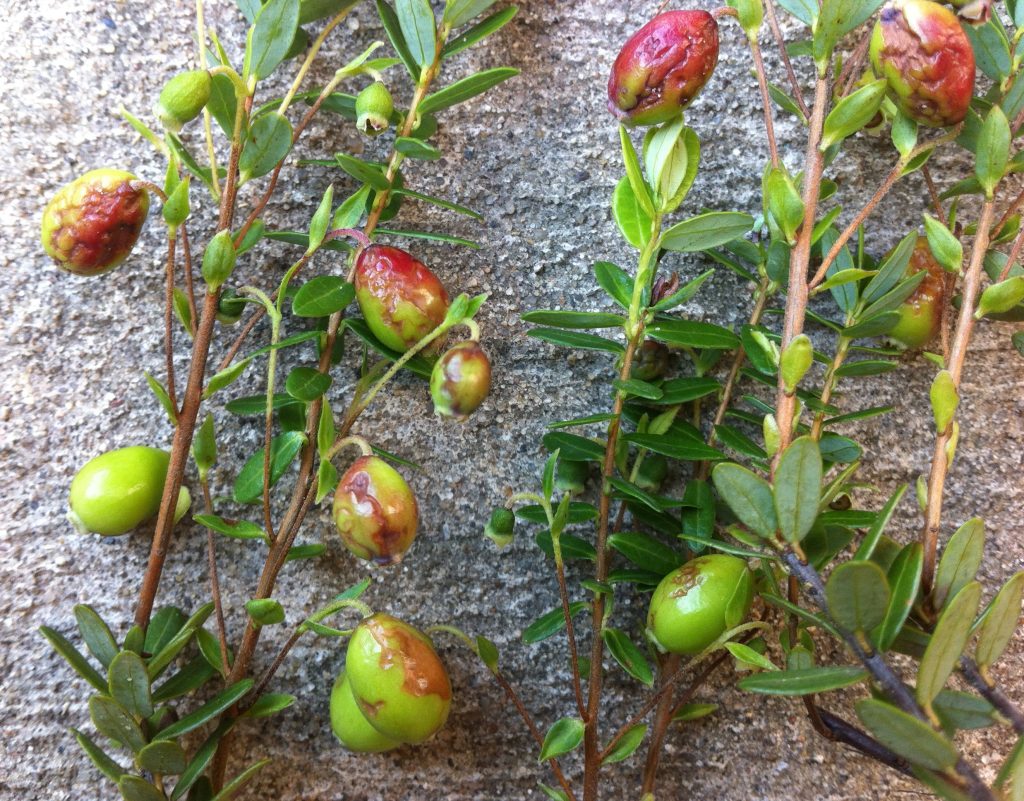Cranberry Viruses

As cranberry beds enter early fruit set, this is an important period to scout for virus-infected fruits. While research demonstrates that infected uprights do recover from Tobacco streak virus and Blueberry shock virus, recovered uprights will continue to carry virus-infected pollen. Beds where a virus has been identified should not be used as a source of cuttings for new beds. This article provides a brief overview of the main viruses that we observe in cranberry in Wisconsin. Cranberries, like many other plants, can harbor viruses. Symptoms of viruses can range from no visible symptoms (asymptomatic) to plant mortality. Expression of these symptoms may vary based on variety, host phenology, and production region. Some viruses have a latent period, where infection occurs but symptoms may take several months or even a year to develop.
Tobacco streak virus (TSV) was first identified in 2012 in Wisconsin cranberries. Infected uprights show decreased average berry weight and reduced percent fruit set in the year that symptoms are present. Uprights that recover from TSV do not differ from healthy uprights in terms of average berry weight, number of flowers produced, and percent fruit set. However, recovered TSV-positive uprights still produce TSV-positive pollen that can spread to healthy uprights.
| Virus family: | TSV is a pollen-borne Ilarvirus |
| Symptoms: *See photos in the fact sheet linked below. | Irregularly shaped, necrotic scars on berries Indented lesions; Fruit cracking Some fruits abort, others mature but are misshaped No symptoms on leaves, stems, runners, or roots Flower and tip blighting (not as common as fruit symptoms; may have other biotic causes) |
| Regions: | U.S.A. – Wisconsin, New Jersey, Massachusetts |
| Susceptible cultivars: | New hybrid and older hybrid varieties Ex. ‘Mullica Queen’, ‘Crimson Queen’, ‘Stevens’, ‘Norman LeMunyon’, others |
| When to scout: | Early fruit set. Berries turn red prematurely, look for “hotspots” of infected uprights; scout for berry scarring during this period as it becomes more difficult to find later in the season when healthy fruits mature (turn red). |
| Source and spread of virus: | The virus is suspected to move in pollen, suggesting possible movement with pollinators. While this has not been demonstrated in field experiments, the virus has been detected on and in pollen. Other modes of TSV transmission in cranberry are not well understood. |
| Management: | Since the role of insects spreading the virus is unclear, it is recommended that you do not apply insecticides. Use virus-free planting stock. If plants used for propagation or breeding test positive for the virus, they should be destroyed. |
Blueberry shock virus (BlShV) was first associated with berry scarring in Wisconsin marshes in 2014. Scarred fruit tested negative for TSV and positive for BlShV. Similar to TSV, uprights infected with BlShV produced scarred berries one year and healthy-looking berries in subsequent seasons (i.e., recovery).
| Virus family/biology: | BlShV is an Ilarvirus |
| Symptoms: *See photos in the fact sheet linked below. | Ringspots, etching, scarring Scarring is very similar to TSV symptomology No foliar symptoms |
| Regions: | U.S.A. – Wisconsin, Massachusetts |
| Susceptible cultivars: | Most frequently reported in beds of ‘Stevens’ but confirmed in other cultivars. |
| When to scout: | Early fruit set. Berries turn red prematurely, look for “hotspots” of infected uprights; scout for berry scarring during this period as it becomes more difficult to find later in the season when healthy fruits mature (turn red). |
| Source and spread of virus: | The virus is present in the pollen of cranberry plants; pollinators may carry the virus-infected pollen. Virus-infected planting material (i.e., cuttings) may also result in the spread of BlShV. Infected seeds that can be moved by birds or animals also represents a mode of spread to uninfected areas. |
| Management: | Use virus-free planting stock. Re-flood beds after harvest to remove any infected seeds. If plants used for propagation or breeding test positive for virus, they should be destroyed. |
Things to consider when scouting for virus-infected uprights:
- The best time to scout is during early fruit set in mid- to late July. Scouting later in the summer can be difficult as infected berries may be shriveled or aborted.
- Symptoms associated with some viral diseases of cranberry may be similar to other biotic issues in cranberry, so accurate diagnosis is needed.
- Example: premature reddening of fruits during early fruit set (as seen with TSV and BlShV infections) could also result from insect feeding damage.
- Infected vines do “recover” from TSV and BlShV. In the year following berry scarring symptoms, infected vines are not symptomatic and are indistinguishable from healthy uprights. Despite the absence of symptoms in the years following, these infected vines still produce virus-positive pollen.
- Cranberry uprights infected with TSV or BlShV cannot be cured of the virus. Removal of infected plant material is not practical as healthy plants and recovered plants can not be differentiated in the field.
- If you find uprights containing scarred berries you can submit them to a commercial laboratory for virus testing. Example: Agdia (www.agdia.com).
- If you want to test asymptomatic uprights for the presence of virus, more representative sampling within a bed is required. Consult fact sheets referenced below for instructions.
*Mention of a product or company is not an endorsement.
References
Wells-Hansen, LD and McManus, PS. 2016. Tobacco Streak Virus in Cranberry (A4110). UW-Extension, Cooperative Extension. https://cdn.shopify.com/s/files/1/0145/8808/4272/files/A4110.pdf
Thomas-Sharma, S and McManus, PS. 2017. Blueberry Shock Virus in Cranberry (A4147). UW-Extension, Cooperative Extension. https://cdn.shopify.com/s/files/1/0145/8808/4272/files/A4147.pdf
Polashock, JJ, Caruso, FL, Averill, AL, and Schilder, AC. 2017. Compendium of Blueberry, Cranberry, and Lingonberry Diseases and Pests, 2nd Edition.
This article was posted in Cranberry, Disease and tagged Blueberry shock virus, Cranberries, cranberry viruses, disease, Leslie Holland, Tobacco Streak Virus, Viruses.
